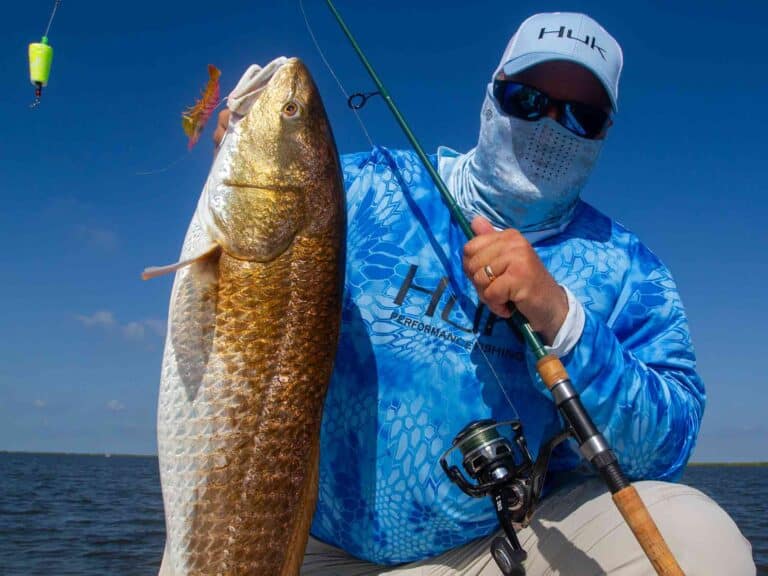Drifting off the Marin coast on a flat ocean and inside the bight formed by Bolinas Point, the tattered patches of bait that lit up our depth-finder screen told us that the salmon were here. Trollers covering the same stretch complained on the radio about the on-and-off hookups, another indicator the salmon were on a select diet. It was clear we needed a different strategy.
Set up with tackle more suited for black bass, we were drifting bucktail jigs armed with circle hooks and baited with anchovy fillets. We positioned the jigs 25 feet down in the water column, and from that point on, we let them sit.
Patience and long drifts are key to intercepting fish in open water, and eventually it pays off. Our good friend Bob Akers, guarding the stern rod, got the first bite, and luckily this visitor did not intend to leave. Suddenly the rod bent, and Bob lifted into a heavy, head-shaking chinook before it took off on a panicked-hot run.
After the usual give and take, Akers eased the seemingly exhausted fish toward the net. Just as my brother, Angelo, attempted to make the scoop, the fish exploded above the rim and then dove under the boat. We held our collective breath, and on the next try, an estimated 20-pounder thrashed in the net.
The commotion brought attention to our boat, and within minutes of dropping our jigs, more strikes followed. We landed three more shiny chinooks, and although it wasn’t a wide-open bite, we were doing a lot better than the trollers fishing nearby.
By Any Name
How the term “mooching” came about I don’t know, but what it means is drifting bait for salmon. The technique is effective during particular times when bait schools stage near the coastline. Salmon go on heavy binges as they feed on this abundant forage to build up vital fat reserves for their eventual upstream run.
And like that couch potato who has had too much to eat, the salmon get fussy. Instead of an all-out charge, they are content picking off slow-moving injured baits. That’s when dropping a baited bucktail jig can be deadly, since it plays into this feeding pattern. A plain bucktail jig works occasionally, but sweetened with an anchovy fillet, it becomes 10 times more effective. Not only is it simple and productive, it’s a fun way to fish, especially when you’re fighting chinooks in the 15- to 30-pound class on lighter tackle.
Bait, Up and Down
Obviously, locating a hot sign considerably narrows your odds when fishing with bucktail jigs. Look for pileups of working seabirds such as pelicans, terns, gulls and common murres. The birds indicate that the bait is being forced to the surface by pods of salmon pushing them from below.
In other, more-subtle events — particularly when you have a cloudless sky, flat water, and a lack of obvious bird activity — bait schools forced to the surface appear as brown blobs. Good polarizing sunglasses are a big advantage when looking for this out-of-place color. Anchovies, sardines, sand lance and huge masses of krill can make up these surface blobs.
Fishing to bait schools high in the water column adds immensely to the fun factor because it’s all visual hunting, followed by running up to make your play. However, it’s important as you approach an active sign not to barge full bore
nto the scene. You’ll spook everything and put the action down.
Calm down, back off on the throttle, and ease in. I always target the outer edges of the working birds or bait schools because that’s where the majority of the salmon feed. Once the boat is in position, if you can see the bait, or it’s showing high in the water on the depth-finder screen, generally dropping the jig 15 to 50 feet down puts you in the strike zone. When fishing this shallow, I do well using a ½- to 1-ounce white jig.
Of course there will be days when there is no hot sign on top, and the bait is holding deeper and spread out. When this happens, I position upwind or uptide, and then drop the jigs to the level of the bait schools and make long drifts.
Acute Angle
A nearly vertical-line angle is best, as it allows you to get a better read on the bite, and you know the jig is at the right depth. Should the line start to plane up due to a fast drift caused by wind, lay out a sea anchor. You can also add weight to the line by placing a ¼- to ½-ounce rubber-core sinker 2 feet above the jig. Once the jig gets down to the feeding zone, you can hold it or put the rod in a holder. You don’t need to move the jig much to attract attention. The motion of the boat is often enough, or a light pumping motion can be imparted.
With circle hooks, you have to allow time for the salmon to take the bait and move off, which pulls the hook into the corner of its mouth. If you have an itchy trigger finger, you’re going to strike out every time.
You’ll be amazed by how deceptive salmon can be, regardless of size, when they try to steal the fillet off the hook. It often starts with a single tap, which you’ll see at the rod tip. Don’t set the hook! With a circle hook, you’ll miss them almost every time. Wait until the rod tip loads, then slowly lift and reel into the fish until the line comes tight, then hang on for a tough fight. Be prepared for anything if you latch onto a shiny 30-pounder.













